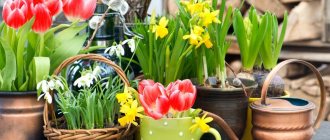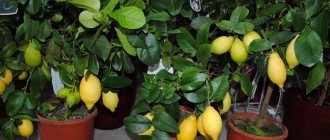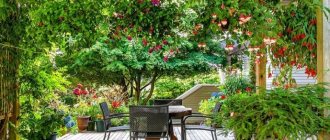Climbing indoor plants: photos and names
In modern interior design, various climbing plants and flower arrangements are increasingly being used as decoration.
Firstly, this is a great eco-friendly solution for your home. Secondly, it is a very good option if you need to somehow divide the space of the room. This is where different compositions come in handy. And thirdly, this is, of course, an interesting and unusual arrangement of the room.
Curly compositions are completely different and for every taste. They can have either a rich, bright color or a calm, muted color.
Let's look at the main types of such plants, which of them are now the most popular and how to properly care for such decor.
Monstera
A spectacular flower with huge carved leaf plates up to half a meter in length and width. At home, it is better to grow monstera in spacious rooms. The thick stem has many hanging roots. With them, the monstera masterfully clings to any bulges. For this reason, the plant must be provided with reliable and strong support. Loves moist soil and good, but not too bright light. The monstera reveals all its beauty in the fifth year of its life.
Small-leaved plants
Small-leaved plants almost always have bright, rich colors, but at the same time they have a sophisticated and neat appearance. The shades of such plants vary from bright green to soft purple. There are species with both spotted and plain colors. Leaves can be oval-shaped, with pointed corners, or carved.
The most popular types of this typology of plants are:
- Cissus
- Scindapsus
- Ivy
Cissus is one of the favorites of home gardeners because... it does not require close care, germinates very quickly and allows you to grow a small vine yourself. This plant belongs to the grape family, and therefore evokes some associations with a grapevine, but, unfortunately, it will not grow tasty berries.
Since cissus is essentially a vine, its shoots are very tenacious and can easily bend around various objects. As mentioned above, caring for cissus is not difficult. First of all, you need to remember that this plant loves warmth, so for stable growth it needs a temperature of 18 degrees. The lighting should be bright, but diffused. But here a lot depends on the variety of cissus. There are types who love darkened places, and there are those who, on the contrary, are ready to bask in the bright rays of light all the time. It is worth watering the plant at a certain frequency - as soon as the first layer of soil dries out, it means it’s time to water your plant.
Another favorite plant of gardeners is scindapsus. It belongs to the Araceae family (this means its natural habitat is the tropical forests of southeast Asia). Perhaps this is what makes these plants very well adapted to their environment. They can survive both in the scorching sun and in dark corners. Since this species also belongs to vines, it sprouts quite quickly and clings to everything around it. If you want your plant to be lush and look healthy, you need to pinch it a couple of times a month.
Probably the most popular option of all is common ivy. It is distinguished by the fact that it is completely unpretentious in care, is hardy to various conditions and germinates very quickly. This plant does not require any special lighting or temperature conditions. The only thing is that common ivy needs abundant watering. Especially at the time of germination, then the amount of water can be reduced.
Eschynanthus
Another interesting climbing flower with red flowers. It is not used very often in indoor gardening. Perhaps this happens because retail outlets offer aeschynanthus quite rarely. A very showy plant will feel great in a hanging pot. The shoots of the flower tend downwards and are decorated with bright red inflorescences. You can find flowers of aeschynanthus from red-orange to dark burgundy.
The stems grow up to half a meter. Over time, the older part becomes compacted and woody. The leaves of the vine are up to nine centimeters long. The flowers resemble tubes, narrowed on one side, and collected in inflorescences. The favorite part of the room for this plant is east and west. There is a lot of light and not too hot in the summer. During plant growth (spring - summer), water regularly. Before each subsequent moistening, it is worth checking the soil; the top layer should be dry.
Leafy plants
This type of plant includes those that have large and large leaves. The main types are:
- Monstera
- Syngonium
- Philodendron climbing
Each of us has at least once encountered a monstera in our home or office. This has unprecedented popularity among both flower growers and ordinary people. It has been proven that Monstera has the ability to ionize the air, so having such a flower in your home is almost necessary, especially if there are small children in the house. Monstera has large leaf blades with obvious cuts, sometimes reaching the central veins. If you decide to have such a plant at home, then remember several features when caring for:
- Monstera loves bright, diffused lighting
- Monstera is a small lover of water; during the germination period it is necessary to water it abundantly, but gradually the amount of water can be significantly reduced
- Monstera is a fairly heat-loving plant, so you need to try to maintain the temperature at least 20 degrees (in winter, at least 16)
- Monitor the air humidity near the monstera. If the room is too dry, try spraying the leaves at regular intervals.
- Monstera juice contains poison, so try to place the plant out of the reach of children.
Another plant from the liana family is syngonium. We have a large number of species and varieties of this plant, but each of them has outstanding and large leaves. The color of such a plant is often spotted (green combined with white). At an early age, the leaves may have the shape of a heart or an arrow, which will give the plant an unusual and beautiful appearance. In adulthood, the leaves gradually begin to resemble Monstera. The plant does not require any unnecessary trouble to care for. It should be watered frequently and abundantly, but in terms of lighting and temperature, the plant is ready to adapt to any conditions.
Another popular plant that is probably found in every office is the climbing philodendron. At the moment, there are more than 900 species of this plant, and many still remain unexplored. Philodendron climbing is the species that is most often grown at home. This species does not need a lot of space to grow, it loves shade and is ready to live in any place where it is assigned. This plant loves water, so be sure to provide it with water at room temperature regularly. If you want to give the plant splendor, then you should periodically pinch it from the top, and place all the branches on supporting structures.
Hedera
Usually this plant is called simply - indoor ivy. This flower has carved delta-shaped leaves and strong creeping shoots. The plant is not considered difficult to care for. It likes moderate shade and moist soil. However, you should not overwater the hedera; a lump of soil that is too wet will destroy the plant.
This type of ivy has small growths on its stems. If the stem reaches a favorable place, then clinging roots appear from these growths. Ivy grows where this root falls. Be careful. If, having decided to get a hedera, you hang it next to it or place a pot with another plant, then the ivy will not behave very modestly. He can “reach” with a branch to the soil of a neighboring pot and “land” safely in it.
In nature, this plant entwines entire slopes of rocky hills and even the mossy walls of ancient houses. It grows very quickly and hides bare spots. If you need to decorate such a corner in your room as soon as possible, ivy will cope with this task and will not cause any difficulties.
Don't wait for the hedera to bloom. The plant produces buds only at a fairly advanced age (10-13 years). No room is conducive to such a long life of this ivy.
Flowering plants
No less popular now are plants that, in addition to spectacular leaves, also have stunning colorful flowers. Such compositions are most often used in various eco-styles. Flowering plants are suitable for decorating windows, shelves and other surfaces.
Below is a list of the most popular plants in this category:
- Diplandenia
- Stephanotis
- Hoya
- Morning glory tricolor
- Tradescantia
An interesting and unusual flower, found quite often in apartments and houses - diplandia or mandevilla. Yes, yes, don't be surprised. This plant has two official names. And all because at first they discovered some species of this plant and called them Diplandenia, and after some time another group of scientists discovered other types of this flower and called them Mandevilla. Soon they carried out a comparative analysis of these plants and came to the conclusion that they belong to the same genus. This is how one small flower immediately became the owner of two names. What does this flower look like? People call it “Bolivian rose”, and this is due to the fact that this plant has a bright appearance. In fact, this is an evergreen vine that also has a wonderful soft aroma. Daplandenia flowers bloom in warm seasons; they are not very demanding to care for, so flower growers and gardeners are happy to grow them at home. The most important thing is to provide them with warmth, and in terms of other parameters (temperature, watering, etc.) the plant is completely unpretentious.
But the next flower, called “Madagascar jasmine,” is a little more demanding to care for. Officially it is called stephanotis, which translates as “pig ear wreath” and indeed, this plant can grow so that it looks like a wreath with neat curls. With age, the vine can grow up to five meters if you care for it properly. It is best to place the flower in a large free space (a country house option is more suitable here than an apartment). The location of the flower must be calculated experimentally, because It’s impossible to say exactly where it will be better to stand: in the sun or in the shade. The flowers bloom in bunches, and their colors are very diverse.
A distant relative of stephanotius, hoya, also often finds its refuge in the homes of flower lovers. This plant is called “wax ivy” for good reason.
There is wax on the surface of the leaves of the plant, and it can grow up to ten meters. Hence the name. Hoya has a very original appearance and especially its star-like petals. This plant is completely unpretentious in terms of care, which adds another plus when choosing a flowering plant for a room. If you want the flowers to bloom and be lush, then you should place the composition either on the eastern side or on the western side, and also water it constantly. Also note that you should not place the plant in the bedroom, because... it has a strong odor and can disturb your healthy sleep. And no, it is not poisonous! You just may not like to sleep with such a scent in the room.
The next plant is morning glory tricolor. I’m sure you’ve seen this plant more than once, even on the streets, because it’s one of the most popular plant species in nature. It belongs to the Bindweed family. By the way, a well-known vegetable - sweet potato or sweet potato - belongs to the same genus (morning glory). Lianas of this genus are very beautiful and neat, which is why flower growers choose them for decoration. The flowers of this plant have a pleasant light blue tone, but after they bloom, the plant changes its color to purple. This particular type also contains psychotropic substances that are used in medicine.
The final plant on our list is Tradescantia. You can find it in almost every home; even people far from floriculture are happy to purchase this plant. It is completely unpretentious in care and easily adapts to the environment. Tradescantia has both a bright and lush cascade of foliage and beautiful succulent flowers. All of them shimmer in some unimaginable colors and decorate your room. The buds fall off the plant quickly, but the bright foliage remains for a long time. It should be watered frequently and abundantly, but carefully monitor the balance of the soil; it should not be too moist.
Hoya
Often, beginning flower growers purchase scindapsus, which was discussed above, under the guise of Hoya. And all due to the fact that the plant has equally dense and wide leaves. Otherwise they are very different.
The second name of the flower is wax ivy. This is what people called hoya for its flowers and glossy leaves, covered with a waxy coating. There is hardly a person passionate about plants who, having once seen the buds of wax ivy, would not want such beauty for his collection. For some, flowering comes easily, and hoya pleases with clusters of waxy flowers almost continuously. And someone can hardly achieve the blossoming of one or two brushes.
The stems eventually reach a length of up to six meters. The plant tolerates both dry and humid air. Small flowers are collected in lush umbrellas. Some clusters (or umbels) contain up to fifty small buds with five sharp petals. The aroma emanating during the flowering of the beauty is dizzying in the literal sense of the word. It's very bright. Therefore, under no circumstances should a flowering plant be kept in places where people sleep. East windows are the best place to grow hoya. Here it has enough sunny color for rapid growth and lush flowering, and at the same time the foliage does not suffer from sunburn.
Plants with special care
Of course, not all plants are unpretentious and easy to care for, but rather the opposite. Finding light and pliable plants is very difficult. Below I’ll tell you about a couple of plants that are difficult to care for, but it’s definitely worth it.
These compositions include:
- Begonia ampelous
- Passionflower
Begonia is a very popular plant, which has almost one thousand completely different species in nature. Ampelous begonia has lush vines and bright flowers. They bloom for quite a long time - this is one of the reasons why such a plant is in most cases placed on a balcony or gazebo in a summer cottage. The plant loves a lot of abundant sunlight, as well as ample watering. Ampelous begonia should always be kept moist. In addition, at the beginning of cultivation, the plant must be fed with phosphorus (just do not throw leftover fish at it) and potassium.
No less capricious is the beautiful, beautiful passionflower. Due to the unusual structure of the flowers, this plant received the name “cavalier star” or “passion flower”. This flower has a truly Christian origin, which is why it is treated very carefully and carefully. Passionflower is sensitive to temperatures - it cannot be placed in places where there is constant bright sunlight, it does not like heat at all. It is better to determine the location of the flower in the house somewhere in the southern region. The plant must be constantly sprayed and the humidity in the room maintained. And of course, we must not forget to prune the plant once a year for reliable germination.
In addition to the above plants, the most demanding to care for plants include such species as: camellia, crossandra, crocus and many others. What they all have in common is that these crops have a beautiful, spectacular appearance and fascinate with their smell and beauty. They are picky about the environment and do not like drought at all.
Mandevilla
The flower, although attractive, is capricious. The length of the shoots can reach four meters. The leaves are thick, shiny, pointed. The flowers of the vine are large and funnel-shaped, with five petals. They love this vine for its buds, each of which lasts up to ten days. The period when the capricious mandevilla pleases with flowering is also quite long.
Some varieties of these vines have a pleasant aroma. With proper care, flowering lasts from spring until late autumn. The plant does not tolerate cold at all. A temperature of 14 degrees can destroy the beauty. The rest of the care is quite prosaic: good light and properly regulated watering.
If mandevilla is trimmed regularly, it will grow into a lush bush covered in flowers. However, free-hanging plant vines are beautiful in their natural form.
Placing plants at home
One of the main points when keeping indoor loaches is their location and subsequently their shaped development. Most vines choose their own walls and hooks to cling to, but if you decide to help them with this, then such care will definitely not be superfluous. It is important to initially select the central branch and slowly weave it around various surfaces. If you want to give your vine splendor, then pinching twigs and shoots will come to the rescue.
When choosing a style and decor for your home or apartment, do not forget that climbing plants can be a wonderful addition to the interior. You can place one small flower arrangement near the sema indoors, or develop a beautiful climbing wall of plants of various types.
Well, now it's time to get inspired! In our album you can get acquainted with wonderful phyto-compositions!
How to choose the right one for yourself?
When choosing an indoor vine, first of all, you should decide what you like best - original foliage of different colors or beautiful flowering.
- In the first case, it is better to choose decorative deciduous vines: scindapsus, cissus, philodendron, syngonium or ivy.
- In the second case, flowering indoor vines are suitable: hoya, passionflower, stephanotis.
In addition, if you do not have time for complex care for a capricious vine, it is better to choose something more unpretentious, such as ivy, scindapsus or cissus.
Climbing indoor plants: photo
Raphidophora
Slowly but quite confidently gaining popularity in our country. All the sophistication of the plant lies in the feathery leaves. The flower quickly finds support and climbs almost any protruding area. Scourges can reach a length of 4.5 meters. Raphidophora needs pruning. Watering is infrequent. But it is necessary to moisten the leaves and air around the plant at least once every two to three days. Prefers diffused light. In winter, there comes a period when watering is reduced to once every ten days.
Anthurium climbing
To disguise the scindapsus stem, which was slightly bare below, a climbing anthurium , which by this time had accumulated a good volume of plump dark green leaves on the northern window sill. And he even bore the first fruits - a bunch of pearls.
Anthurium climbing. © orchids-shop
He also liked it there, the shoots began to actively grow and send out aerial roots, in the spring it bloomed and already produced many pearl clusters. The rating of the bathroom has jumped significantly.
The only difficulty in handling anthurium is the fragility of the stems and leaves. They must be secured to the support with the utmost care. Only aerial roots, like rubber ones, and nothing is done to them in any way. They are white, do not spoil the view, and with sufficient humidity, they climb from everywhere.
The rest of the plant is also very unpretentious. And his health is fine. The growth rate is slow at first, then average, bushes well. Broken shoots readily take root.
Philodendron
Prized for the appearance of its leathery leaves. Depending on the type, their sizes can vary from 15 to 40 centimeters. Many types of philodendron are grown as hanging plants, but if you want a large, fast-growing vine, choose the ivy variety. In winter, at a temperature of +13 degrees, the plant has every chance of dying. Do not place the philodendron in drafts. Do not place in direct sun. But moderate lighting and the same humidity of the soil ball will contribute to the good development of the specimen. It will feel good if you occasionally spray it on the foliage with boiled water. Propagated only in the warm season by cuttings from the stem.
We hope the information about the most common types of indoor vines with photos and names was useful to you. And you were able to choose a plant that is ideal for your home conditions.
Begonia ampelous
Ampelous begonia
Spectacular and bright ampelous begonia pleases the owner with beautiful voluminous double flowers in white, pink or red from spring to autumn. The shoots of this plant are drooping, with bright green leaves, so it is better to grow it in a hanging pot. Care:
- Begonia feels good in conditions in which a person is comfortable. The optimal air temperature is 18–20 °C. She is not afraid of changes from 12 to 25 °C.
- The flower loves fresh air and withers in a stuffy atmosphere.
- The soil needs to be fertile, slightly silty, and watering should be plentiful in the warm season.
- In early spring, the plant should be fed two or three times with nitrogen-containing fertilizer. During flowering, begonia will be happy with mineral fertilizers.
Jasmine
Indoor jasmine
Indoor jasmine is not at all similar to the outdoor false mock jasmine, although it blooms with similar delicate white flowers and aroma. Homemade jasmine is arranged in the form of an arch or as hanging houseplants. Be careful and do not sleep next to blooming jasmine: the persistent, pungent aroma often leads to headaches in the morning.
Caring for jasmine is simple. It is not capricious in the heat and can withstand cold temperatures down to 8 °C. It loves light and does well when exposed to direct sunlight, which is best avoided. When watering, make sure that the lump of earth is always moist. It is better to use soft water (rain/filter) for humidification. In dry weather, jasmine is sprayed. Once a week, the flower needs to be fed with mineral fertilizers.
Akebia
Akebia quinata is a chocolate vine that not everyone decides to grow in their room yet, because it is a real giant even in a potted format. Annual growth is from 1 to 3 m in nature and only slightly less in rooms. True, it is quite easy to restrain the growth of a plant.
Akebia got its name as a chocolate vine for the dizzyingly delicious aroma of its flowers. During flowering, which lasts from April to August in comfortable conditions, the original purple female and light pink male flowers bloom. And all this time you can’t move away from the vine, because you just want to unravel the nuances of the smell.
And although akebia does not bear fruit, the beauty of this semi-evergreen steeplejack with purple shoots that can easily cover any support with five-lobed shiny leaves in one season is quite enough.
Akebia needs a cool winter, and without it you can’t count on success. She loves the sun and air, is not afraid of drafts, but is sensitive to dampness. And it grows well even at low air humidity.
Akebia quinata. © guildfordgardencentre
Passionflower
The daily growth in comfortable conditions of passionflower (Passiflora caerulea), a special vine in every sense, can reach 10 cm, not to mention how quickly it grows over the season.
The evergreen vine is famous for its huge, star-shaped flowers that look like fancy orders with a luxurious crown around the pistil and stamens. But the beauty of the shiny, five- or seven-lobed, up to 20 cm in diameter, rich green leaves should not be underestimated.
Passionflower clings to supports and surfaces with its tendrils, almost never stopping, requires strong regular pruning and rarely fits on a window. A cool dormant period without fertilizing is rather conditional for it, and it adapts to lighting much better than its reputation suggests.
Passionflower (Passiflora caerulea). © flowercouncil
morning glory
Morning glory
This annual climbing plant is often used to decorate balconies, gazebos, and verandas. It beautifully weaves around trellises and posts, decorating everything around with bright purple or pink flowers. The plant, which reaches a length of up to 10 meters, can be planted at home. To do this, you will have to build an arch from wire or let morning glory along the wall.
Morning glory seeds are planted in one pot or flowerpot, several at a time. Of the sprouts that appear, 3–5 of the strongest ones are left, and the rest are removed. The flower loves warmth and sunlight, and dies from the slightest frost. Watering is moderate, it is carried out when the top layer of soil dries. Seasonal feeding:
- during the growth period - ammonium nitrate;
- when buds appear - a mineral complex;
- during flowering - a mineral complex with the addition of nitrogen.











